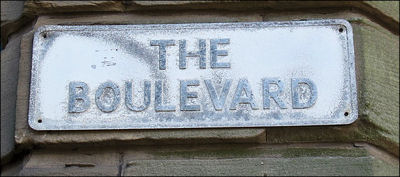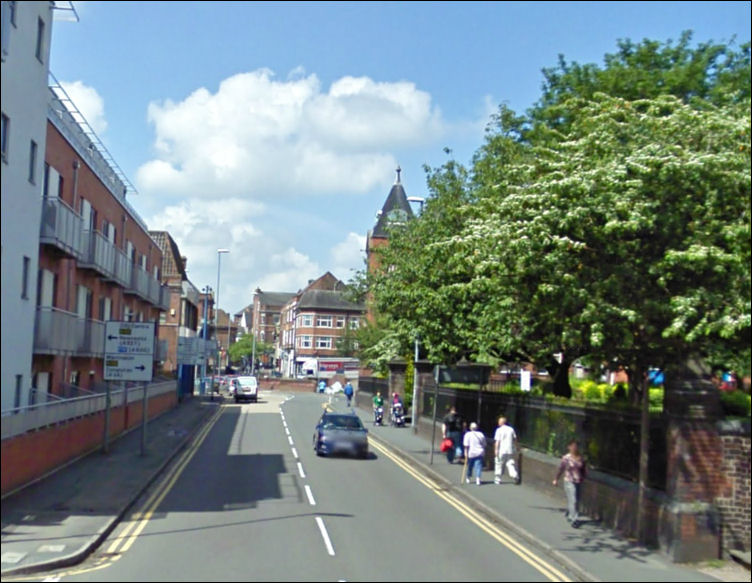| |
|
![]() back to Another 'Grand Tour' index
back to Another 'Grand Tour' index
Another 'Grand Tour' of the Potteries
- David Proudlove &
Steve Birks -
buildings in
Tunstall
![]()
![]()
![]()
next: Tunstall Town Hall
previous: Tunstall Park
contents: index of buildings in Tunstall
|
No 5 - Tunstall [ location map ] |
|
'Downtown
and the Silver Screen'
Growing up in Packmoor, ‘my town’ was Tunstall. I spent many hours in Tunstall Park. I used to go to the dentist at Tunstall Health Centre. I used to buy my records from ‘Replay Records’ on the High Street. It was also the place of many firsts for me. My first job (apart from my paper round) was at the former Co-op supermarket, fetching trolleys in and stacking shelves. I did my work experience while I was at high school at a Tunstall-based architect’s practice. And my first trip to the pictures was to the old Barber’s Palace on the Boulevard. Tunstall means a lot to me. |


The Boulevard, Tunstall
in the mid 1950's renamed from Station Road
on the left flats which were built on the site of Barbers Picture Palace
Google Street View
|
The growth of the eastern extremities of Tunstall began during the 1870s with the construction of the Potteries Loop Line, and Tunstall Station (hence the Boulevard’s former name). The introduction of this important connection between the towns of Kidsgrove and Hanley led to an increase in development, in particular the laying out of Victoria Park and building of a range of public buildings by the prolific A.R. Wood, one of the city’s most prominent architects and Borough Surveyor.
The
Victoria Institute, Public Baths and Fire Station from Greengate Street
In 1880, the area was still an area of wasteland and earthworks, and the Boulevard was just a small lane called Mill Street. In 1890, the Victoria Institute and Jubilee Buildings were built to designs by Wood to commemorate the golden jubilee of Queen Victoria, with the public library moving there in 1891 where it has remained to this day. It was also home to an art and science school, a museum, public baths and also a fire station: a fine example of Victorian-era paternalism.
The development of this public service hub led to the neighbourhood becoming a very popular place to live, and a series of terraced properties were built, including Stanley Street and Park Terrace, which dates from 1893.
Park Terrace from the War Memorial Gardens
The War Memorial Gardens - a wonderful green urban oasis Bing Maps
Remembering the Fallen of Two World Wars
However, as with the nearby Victoria Park, in recent times, the War Memorial Gardens have been allowed to fall into an appalling state, and have only recently seen some attention thanks to a concerted and passionate campaign for action from concerned local residents.
My generation is probably the last for whom a trip to the pictures had a sense of magic. I will never forget my first visit, and the excitement I felt entering the strange and mystical building. The film I saw was E.T. some 30 years or so ago, and I was enchanted. I also cried like an English footballer at the World Cup when the alien cleared off home.
Films and cinema was still special back then. Computer generated special effects may be impressive, and the Hollywood stars slick, but the whole package – including the mass marketing through today’s multi-media sources – just has no soul. Everything is almost force-fed to you, and so the build-up of excitement as the opening of a new film approaches is gone. Film today is less art and more product.
And the same can be said about the buildings in which you have to watch Hollywood Blockbusters these days. The Potteries once had a host of fine cinemas. Now you have to pay a visit to the monstrous Festival Park to ‘the Odeon’ and sit in an awful tin shed, eating popcorn that is more like cardboard. This apparently is progress. Maybe it’s a sign I’m getting old?
Whilst my memories remain, Barber’s Palace has gone. Replaced by a crappy block of CABE-era flats which take advantage of the views over the War Memorial Gardens from their frontage on the Boulevard, but which also ‘enjoy’ stunning views of Brittain Adams’ depot and warehouse, and the arse-end of the vile Alexandra Park development.
Back over the road brings us to the Victorian-era public service hub that is the Victoria Institute and Jubilee Buildings, and further examples of the municipal neglect that blights the Potteries. The Victoria Institute still stands proud, but is now just home to the town’s library and a vast amount of disused space, whilst the building’s fabric continues to decline.
The public baths off Greengate Street – another building close to my heart, the place where I learned to swim – have been officially abandoned by the City Council, and a community group that proposed the formation of a trust to take them from the council’s hands have given up the ghost, citing a lack of support from the council and the local community. An incredibly sad state of affairs. So much for the Big Society.
Tunstall Public Library, Queen Victoria Jubilee Buildings
Tunstall Public Baths: 19th Century paternalism; 21st century abandonment
an underpass that takes you from the Boulevard into the heart of Tunstall. D.P. 18 March 2012 |
![]()
![]()
![]()
next: Tunstall Town Hall
previous: Tunstall Park
contents: index of buildings in Tunstall
|
Related Pages Tunstall - Station Road and the Loop Line Potteries Railway Loop Line - Tunstall Public Swimming Baths, Tunstall Tunstall Library - the Victoria Institute
|